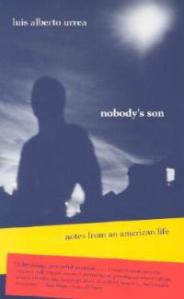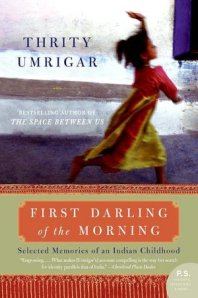Wow, was I excited to attend author events with Thrity Umrigar and Luis Alberto Urrea one day after another the other week. Luis is author of one of my favorite novels, The Hummingbird’s Daughter, a historical fiction “dramascape” set in Mexico that imagines the life of his great aunt Teresa Urrea, “the Saint of Cabora,” who had quite the colorful life, documented in news clippings. Queen of America is the sequel, where Teresa has been exiled to the U.S. and must learn to adapt from the free range of Mexico to the confines of civilized American society of the early 1900s. Thrity Umrigar, whom I just discovered, has written a number of books set in her hometown of Bombay (Mumbai), India.
As documented in his memoir, Nobody’s Son: Notes From an American Life, Luis’s scary Tia Flaca (Aunt Skinny) was the one who passed on stories of Aunt Teresita, the Mexican Indian healer and arbiter for social justice. Tia Flaca, chain-smoking and blind in one eye, squinting as she told the stories she knew. Luis didn’t really take them to heart until a professor showed him a book that mentioned the (in)famous Teresa Urrea. Off he went to do research for ten years to create the magnificent The Hummingbird’s Daughter, which brings Teresa to life the way a nonfiction biography could never do. If you are unsure whether you have enough information to create a memoir or ghostwrite one for a family member, or think you may not have a strong enough story to hold interest as a nonfiction memoir, Writer’s Digest posted Ten Ways to Tell if Your Story Should be a Memoir or a Novel.
Tia Flaca (Aunt Skinny) was the one who passed on stories of Aunt Teresita, the Mexican Indian healer and arbiter for social justice. Tia Flaca, chain-smoking and blind in one eye, squinting as she told the stories she knew. Luis didn’t really take them to heart until a professor showed him a book that mentioned the (in)famous Teresa Urrea. Off he went to do research for ten years to create the magnificent The Hummingbird’s Daughter, which brings Teresa to life the way a nonfiction biography could never do. If you are unsure whether you have enough information to create a memoir or ghostwrite one for a family member, or think you may not have a strong enough story to hold interest as a nonfiction memoir, Writer’s Digest posted Ten Ways to Tell if Your Story Should be a Memoir or a Novel.
Luis Urrea has also written nonfiction about his experiences with poverty along the Mexican-U.S. border. By the Lake of Sleeping Children documents his time helping an orphanage in Tijuana and seeing a community of poor finding food by picking through a huge dump nearby. This is a series of vignettes, and rough—one in particular that turned my stomach. Across the Wire: Life and Hard Times on the Mexican Border was written so Americans could understand the desperation that cause some to risk their lives to come here. He admits that times have changed a bit since the writing of that book as the “narcos” have taken over. The purpose of Luis Urrea’s nonfiction is to draw attention to the plight of poor Mexicans, hoping that stories of real people suffering will bring some degree of empathy to replace disgust, intolerance, and even hate for those who break immigration laws. And, of course, to tell a good story to retain interest.
 Thrity Umrigar, on the other hand, means to tell good stories that just happen to involve Indian history and culture. While she has written a memoir, First Darling of the Morning, which details her rebellious childhood in a minority, middle-class, Westernized family in Mumbai, the rest of her books are novels, and she says she does not put herself into any of the characters. That said, she discovered that the “middle class all around the world has a lot in common,” and believes everyone feels a need “to tell story, to be a part of story, to recognize your own story in that of others’.” Just as Luis Urrea found after writing his stories of the border that little Yacqui Indian kids in Tucson were so happy someone had bothered to write about their culture. Just as you may find when you write your memoir that someone out there needs and wants to hear your stories because they identify with them.
Thrity Umrigar, on the other hand, means to tell good stories that just happen to involve Indian history and culture. While she has written a memoir, First Darling of the Morning, which details her rebellious childhood in a minority, middle-class, Westernized family in Mumbai, the rest of her books are novels, and she says she does not put herself into any of the characters. That said, she discovered that the “middle class all around the world has a lot in common,” and believes everyone feels a need “to tell story, to be a part of story, to recognize your own story in that of others’.” Just as Luis Urrea found after writing his stories of the border that little Yacqui Indian kids in Tucson were so happy someone had bothered to write about their culture. Just as you may find when you write your memoir that someone out there needs and wants to hear your stories because they identify with them.



